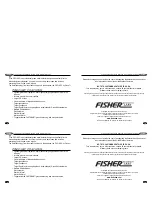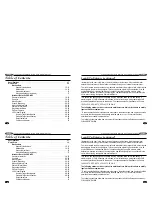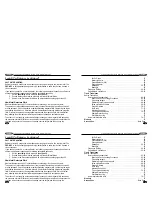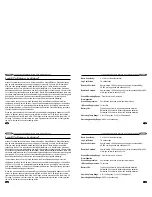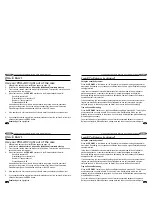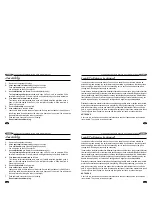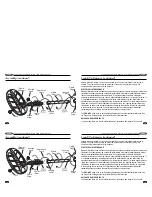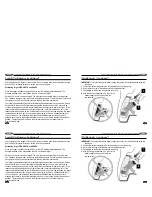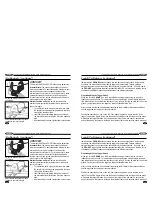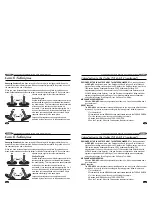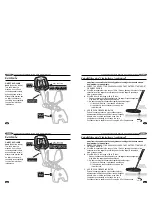
33
Comprehensive Operating Manual & Guide to Metal Detecting
PRO-ARC
22
PRO-ARC
Comprehensive Operating Manual & Guide to Metal Detecting
9
Quick Start (continued)
Rotate the Settings knob to the left (counterclockwise),
Reduce the sensitivity setting until the false signals go away.
After 7 seconds, the machine will exit the menu and return to normal operation.
7.
Find a patch of ground free of metal, toss a coin on the ground and sweep back and forth
over it a few times to get a feel for how the machine responds.
8.
You are now ready to search.
9.
Pull and hold the trigger switch with your index finger to pinpoint the exact location of
targets, making them easier to unearth.
When the trigger is pulled, PinPoint is engaged ….
The searchcoil need not be in motion to detect an object.
The 2-digit numeric display indicates approximate target depth, in inches.
72
Search Techniques (continued)
Negative hot rocks (also called cold rocks) are usually magnetite or contain magnetite,
and give a negative response because their ground balance value is a higher number
than the soil they are found in. They tend to be dark in color, usually black, and usually
heavy. In some cases they will have rust stains. They are usually attracted to a magnet,
and for this reason gold prospectors always carry a magnet-the ultimate
ferrous/nonferrous discriminator. In Motion All Metal Mode, negative hot rocks produce a
boing sound rather than the zip sound of a metallic target; recognize the difference and
you will learn to ignore them.
Positive hot rocks are iron-bearing rocks which have been oxidized by natural weathering
processes so that their Ground Balance number is a number lower than the soil they are
found in. They are often small, right on the surface, sound just like a gold nugget, and are
common in many gold prospecting areas. They are usually, but not always, drawn to a
magnet. They are most often reddish in color but are often black, brown or yellow. On
some sites, red clay bricks and rocks which have lined a fireplace or a campfire will often be
hot rocks. The discriminator will usually eliminate them without difficulty if widely scattered,
but if there is a large concentration of them, the discriminator may not quiet them all. In that
case, you can revert to the rule of thumb -- “don't dig non-repeatable signals.”
33
Comprehensive Operating Manual & Guide to Metal Detecting
PRO-ARC
22
PRO-ARC
Comprehensive Operating Manual & Guide to Metal Detecting
9
Quick Start (continued)
Rotate the Settings knob to the left (counterclockwise),
Reduce the sensitivity setting until the false signals go away.
After 7 seconds, the machine will exit the menu and return to normal operation.
7.
Find a patch of ground free of metal, toss a coin on the ground and sweep back and forth
over it a few times to get a feel for how the machine responds.
8.
You are now ready to search.
9.
Pull and hold the trigger switch with your index finger to pinpoint the exact location of
targets, making them easier to unearth.
When the trigger is pulled, PinPoint is engaged ….
The searchcoil need not be in motion to detect an object.
The 2-digit numeric display indicates approximate target depth, in inches.
72
Search Techniques (continued)
Negative hot rocks (also called cold rocks) are usually magnetite or contain magnetite,
and give a negative response because their ground balance value is a higher number
than the soil they are found in. They tend to be dark in color, usually black, and usually
heavy. In some cases they will have rust stains. They are usually attracted to a magnet,
and for this reason gold prospectors always carry a magnet-the ultimate
ferrous/nonferrous discriminator. In Motion All Metal Mode, negative hot rocks produce a
boing sound rather than the zip sound of a metallic target; recognize the difference and
you will learn to ignore them.
Positive hot rocks are iron-bearing rocks which have been oxidized by natural weathering
processes so that their Ground Balance number is a number lower than the soil they are
found in. They are often small, right on the surface, sound just like a gold nugget, and are
common in many gold prospecting areas. They are usually, but not always, drawn to a
magnet. They are most often reddish in color but are often black, brown or yellow. On
some sites, red clay bricks and rocks which have lined a fireplace or a campfire will often be
hot rocks. The discriminator will usually eliminate them without difficulty if widely scattered,
but if there is a large concentration of them, the discriminator may not quiet them all. In that
case, you can revert to the rule of thumb -- “don't dig non-repeatable signals.”


